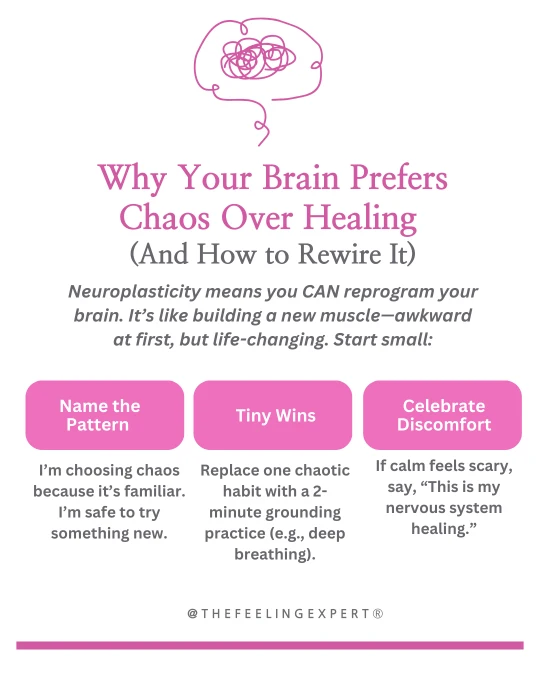
Have you ever caught yourself repeating patterns of chaos that don’t serve you? Maybe you lash out when you’re overwhelmed, shut down in relationships, or stay stuck in habits that sabotage your progress. You know they’re not helpful—but you do them anyway.
You’re not broken. You’re not lazy. And you’re definitely not alone.
What you’re experiencing is your brain’s attachment to what it knows. Even if what it knows is chaos.
Let’s break this down.
Neuroscience tells us our brains are wired for efficiency, not happiness. If you’ve spent years—or decades—navigating stress, trauma, or instability, your brain has learned to expect chaos. It becomes the default setting. Even if it’s painful, it’s predictable.
This isn’t a conscious choice—it’s a survival response. But the good news? Neuroplasticity means your brain can change. It can be rewired to embrace calm, safety, and stability. That process might feel uncomfortable at first, but it’s deeply healing.
1. Past Trauma
If you grew up in an unpredictable or emotionally unsafe environment, your nervous system may still be operating in survival mode. Your brain developed coping patterns that helped you then—but those same patterns might be harming you now.
2. Low Self-Worth
If you carry the belief that you don’t deserve peace, success, or love, you may unconsciously sabotage those things. Healing requires believing you’re worthy of something different.
3. Fear of Success or Failure
Sometimes success feels just as threatening as failure. Why? Because success introduces new expectations—and new chances for disappointment or rejection. The brain may prefer the familiar discomfort of failure to the unknown vulnerability of success.
4. Emotional Overload
When emotions become too intense to process, it’s natural to look for a release valve. This might show up as impulsive spending, binge eating, lashing out, or numbing with substances or screens. These behaviors distract us from emotional pain—but they also keep us stuck.
Recognizing Self-Destructive Patterns
Self-destructive behavior isn’t a personality flaw. It’s a coping mechanism—a way your system tries to create relief. But long-term, it reinforces stress and disconnection.
So how do you begin to change it?
Healing begins with awareness. Noticing the pattern without judgment is the first step. From there, you can make intentional, compassionate changes that help you regulate, repair, and realign.
5 Steps to Interrupt the Chaos and Begin Rewiring Your Brain
1. Pause and Identify the Trigger
When you feel the urge to act in a way that doesn’t serve you, stop and ask:
What am I feeling right now?
What just happened that stirred this up?
Is it fear? Rejection? Shame? Naming the emotion gives your brain a moment to slow down—and puts you back in the driver’s seat.
Try saying: “This is fear talking. I can listen without reacting.”
2. Practice Self-Compassion
Many of us criticize ourselves for falling back into old patterns. But judgment doesn’t create change—compassion does. Talk to yourself like you would a close friend.
Instead of: “Why do I always mess this up?”
Try: “I’m noticing an old pattern, and I’m learning how to shift it.”
Even saying, “This is hard, but I’m trying,” can change the emotional climate in your body.
3. Replace the Behavior
Once you’ve named the pattern, try swapping it for a grounding alternative.
Instead of:
Try:
You don’t have to “fix” the emotion—just create a safer space for it to move through you.
4. Set Tiny Goals
Your nervous system doesn’t like drastic change. Start small.
If you struggle with procrastination, try working for just five minutes. If rest feels impossible, lie down and breathe for two minutes. These small actions signal to your brain: It’s safe to try something new.
Tiny wins build big trust with yourself.
5. Celebrate the Discomfort
Here’s a powerful truth: healing can feel scary. Calm can feel foreign. When you’re used to chaos, stillness might make your system panic.
If you feel anxious when things are peaceful, remind yourself:
“This is my nervous system healing. It’s okay to feel uncertain.”
Discomfort doesn’t mean you’re doing it wrong. It means you’re doing something different.
Why This Matters: The Power of Rewiring
When you begin to shift out of survival mode and into regulation, something incredible happens:
It’s not about becoming perfect. It’s about becoming present.
Let’s Recap: A Quick Framework to Shift Out of Chaos
Here’s the Rewiring Chaos Framework from The Feeling Expert:
Name the Pattern
“I’m choosing chaos because it’s familiar. I’m safe to try something new.”
Tiny Wins
“Replace one chaotic habit with a 2-minute grounding practice.”
Celebrate Discomfort
“If calm feels scary, say: ‘This is my nervous system healing.’”
Each time you walk yourself through this framework, you build a new neural pathway—one that leads to peace, connection, and emotional strength.
Final Thoughts
Healing isn’t linear. Some days will feel like breakthroughs. Others will feel like setbacks. But every time you choose curiosity over criticism, grounding over chaos, compassion over self-blame—you’re doing the work.
You’re creating safety in your system.
You’re becoming someone who can hold calm, joy, and love—not just chaos.
And that’s something to celebrate.
Ready to go deeper?
If you’re a high-achieving woman navigating overwhelm, people-pleasing, or emotional reactivity, The Feeling Expert is here to support your healing journey. Our resources are created for nervous system regulation, trauma healing, and self-worth work—without the fluff.
✨ Join our next group session or sound healing experience.
✨ Follow us on Instagram @thefeelingexpert for more tips.
✨ Or schedule a 1:1 consultation to explore your healing path. Book a free 15-minute consultation
You’re not too much. You’re not too late. You’re just in the middle of becoming.
Let’s heal forward—together.
The Feeling Expert is licensed to provide in-person, online video or phone holistic psychotherapy and mental health counseling throughout the state of Florida.
Sign up for tips and insights delivered straight to your inbox: Mindful Healing: Insights to Heal Your Past & Thrive. Get tips to help you as you heal from trauma, connect with your authentic self, and create balance in your daily life.